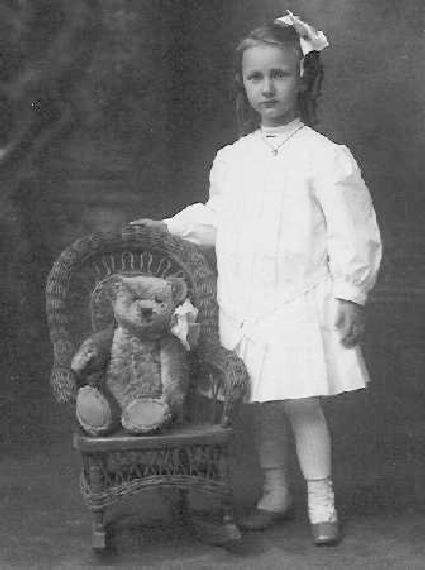
Boys' Tunics: Gender

Figure 1.--This American portrait shows a child sometime around the turn of the century, we would guess about 1905-1910. The teddy bear is a strong indicator that it was not before the turn of the century. We believe that the child is a girl, but we are not positive. The portrait was taken in Boston.
|
HBC believes that the tunic has been a primarily boys' garment, although our information has been admittedly limited. Cerainly tunics in the 19th century, as far as we can tell, were boys' garments. We have few written sources to substantiate this. Based on the images we have seen, however, the tunic certainly seems to be a boys' garment. We are less sure, however, about the 20th century. Some images suggest that in the early 1900s that tunics were also worn by girls, at least in America. We are not sure, however, how common this was and we hope HBC will be able to add further insights on this matter.
Chronology
HBC believes that the tunic has been a primarily boys' garment, although our information has been admittedly limited. There may be some variation over time. Cerainly tunics in the 19th century, as far as we can tell, were boys' garments. We have few written sources to substantiate this. Based on the images we have seen, however, the tunic certainly seems to be a boys' garment. We are less sure, however, about the 20th century. The tunic increased greatly in popularity at the turn of the 20th century, especially in America.
Individuals
Some images suggest that in the early 1900s that tunics were also worn by girls, at least in America. Tunics at the turn of the century, were especially popular in America. We have less information about other countries. Perhaps the two most notable examples of turn of the century tunics were photographs of Quintin Roosevelt wearig a tunic and even more well known Buster Brown. HBC knows of no well-known girl wearing tunics. We note many photographs of boys wearing tunics and girls wearing white dresses.
A famous portrait of President Roosevelt and his famiy shows Quintin wearing a yellow tunic. Thetunic was clearly a boys' garment, although Quintin's sister does wear a tunic-like dress.
Buster Brown is of course famous for the tunic suit he wore and it even came to be known as a Buster Brown suit. Notably, Buster's friend Mary Jane, always wore a dress.
We note many turn of the century American photographs of boys wearing tunic suits and girls wearing dresses. Commonly both wear white, although this is not always the case.
Photographs
HBC has numerous photographs of children at the turn of the century wearing tunics. Many of these photographs are unidentified and we do not yet have verified photogrphs of girls wearing these tunics, but we believe the they did.
While the portrait here is undated (figure 1), the teddy bear is useful in dating it to after the turn of the century. Almost certainly this photograph was tken after 1902.
Indicators
HBC notes that there are several accessories and accompanying gaments that are worn with tunic suits. We do not yet know, however, precisely how these can be used to assess the gender of the children wearing tunic suits.
Headwear
The most common headwear assciated with tunic suits is the wide-brimmer sailor hat. This could be worn by both boys and girls. The soft sailor cap worn by Buster Brown in the Buster Brown films is more of a boys' cap.
Hair styles
This is dificult as some boys at the turn of the century still wore long hair and curls. Some boys ever had hair bows. Short hair of course strongly suggests a boy. Ringlets curls were often worn by boys, but after about 1905-10, ringlets become more associated with girls than boys. While not common for boys, even American boys, wore hair bows. The boys hairbows were generally small compared to those worn by girls.
We do not know of any stylistic differences in the tunics worn by boys and girls. We do note that some boys wore rather short tunics showing much of their bloomer knickers. Other boys wore much longer tunics, usually showing at least the bottom of their bloomer knickers. The images that we believe ar girl generally do not show these bloomer knickers. Complicating the issue, some of the image that we know are boys also do not show the bloomer knickers. While the basic style appears indenical, we believe some of the detailing may have been different for girls.
Color
We are not yet sure out color. White was worn by both boys and girls. We do not believe that modern color conventions were yet established.
Stockings and footwar
At the turn of the century, younger boys and girls wore very similar stockings and footwear.
Image
Various elements suggest to HBC that the child here is probbly a girl. The hair boy seems larger than those normally worn by boys, although the ringlets are vry similar to those worn by boys. The locket (on a child this age) raher uggests a girl. The child's face seem raher girlish. The fact that the bloomer knickers boys wore with these tunics do not show also uggests that it may be a girl. Whle HBC believes tht the child is probanly a girl, we are not positive.
Christopher Wagner

Navigate the Historic Boys' Clothing Web Site:
[Introduction]
[Activities]
[Bibliographies]
[Biographies]
[Chronologies]
[Countries]
[Style Index]
[Contributions]
[Frequently Asked Questions]
[Glossaries]
[Satellite sites]
[Tools]
[Boys' Clothing Home]
Created: February 4, 2002
Last updated: July 1, 2003



